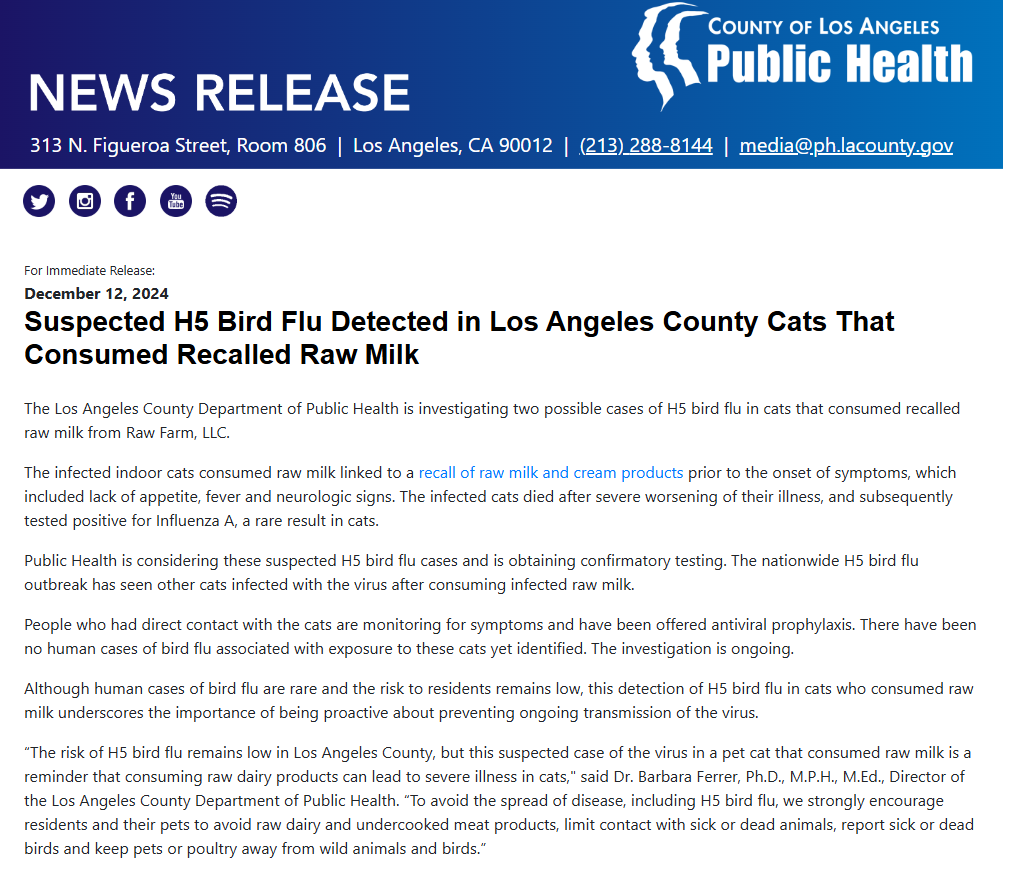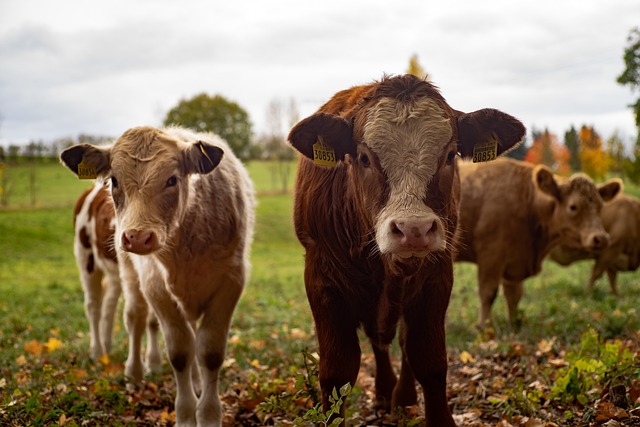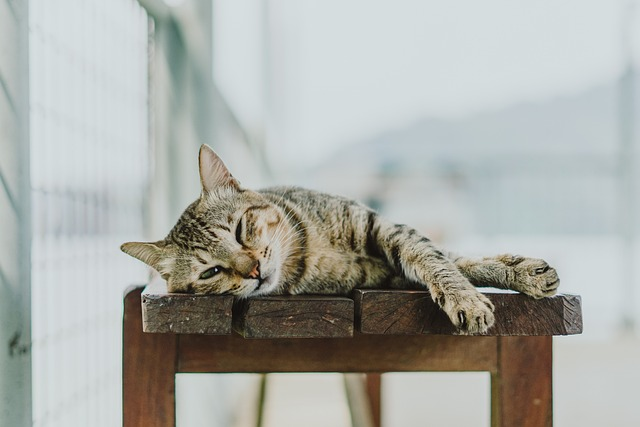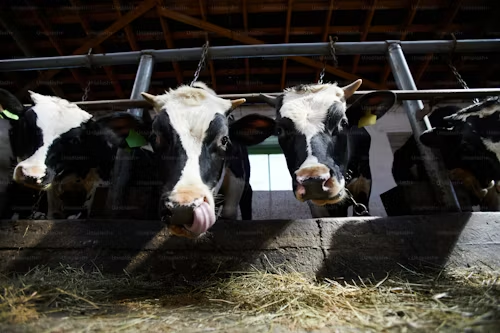Two indoor cats in Las Angeles County are reported to have died from H5N1 after consuming raw milk. The cats first suffered symptoms including “lack of appetite, fever and neurologic signs,” but after “severe worsening of their illness” both cats died. Testing came back positive for Influenza A, and the local public health department considers these suspected H5 bird flu cases with further testing pending.

It should be noted that the milk fed to these two cats was apparently from Raw Farm, LLC, which recently issued a recall for multiple batches of its raw milk as it was positive for H5N1. Anyone feeding their cats raw milk right now, especially from a producer that has confirmed H5N1 infection in its milk, is taking a huge risk with the lives of their animals. Indeed, the health alert from Las Angeles County specifically cautions against people drinking raw milk or providing raw milk to their animals as well as the usual avoidance of contact with wild birds:
“To avoid the spread of disease, including H5 bird flu, we strongly encourage residents and their pets to avoid raw dairy and undercooked meat products, limit contact with sick or dead animals, report sick or dead birds and keep pets or poultry away from wild animals and birds.”
We have known that cats could get infected with influenza, but such instances were rare. However, with the emergence of clade 2.3.4.4b H5N1, there have been some very severe cases resulting in neurological symptoms and deaths. Further, since the virus spilled over to dairy cattle last Spring, there has been an uptick in reported cat deaths caused by H5N1.

In the summer of 2023, at least 30 cats in Poland died of H5N1 after consuming raw chicken meat that contained the virus. (I previously wrote a post diving into this outbreak which at first was shrouded in mystery, see H5N1 contaminated meat caused the deaths of 30 Polish cats from bird flu.). In summary, cat owners had watched their pets suffer severe respiratory symptoms including pneumonia, and neurological symptoms and seizures. In describing the clinical picture of the cats, one case study described a “systemic inflammatory response” that affected many internal organs, including the lungs and brain. Thankfully, no humans got sick from exposure to their cats, but the cats died terribly.
One unusual thing about the Polish cat cases was the discovery of two very rare mutations, which were found in all the cat viruses: PB2 E627K and K526R. These mutations are independently known as markers of viral adaptation to mammals, so finding just one of them would be noteworthy. It is incredibly rare to find them together. These mutations were also found in samples of H5N1 positive frozen chicken meat provided by cat owners.
Around the same time as the Polish cat outbreaks, 38 cats died of H5N1 at an animal shelter in South Korea. The virus was found at another shelter that same month, where four more cats died. The cats had been infected by eating contaminated raw duck meat.
In December 2022, H5N1 was reported in a deceased cat that lived on a duck farm with H5N1 infection. The cat reportedly displayed “pronounced neurologic and respiratory symptoms” requiring euthanasia. (The sequence of this cat also had the PB2 E627K).
In April 2023, a farm in Italy reported that one cat and several dogs had tested positive for the virus but were asymptomatic. (Of note, the virus from the dogs and cat carried the same mutation as the virus that had infected a Spanish mink farm in October 2022.).

With the outbreak of H5N1 amongst dairy cattle in the U.S. came additional cases in cats, primarily cats who lived on infected dairy farms and who were exposed to infected raw milk or infected wild birds in the area. The “close interactions and proximity” of cats and humans has been cited by the CDC as a concern as that, along with the “rapid selection of mutations” in a mammalian host, “could result in a virus with potential for interhuman transmission, indicating a considerable public health threat.” Their role as a potential intermediate host may warrant further study as the current clade of H5N1 is showing itself more fit to infect mammals than the virus has before.
To that end, in a very recent study, Marked Neurotropism and Potential Adaptation of H5N1 Clade 2.3.4.4.b Virus in Naturally Infected Domestic Cats, Emerging Microbes & Infections, it was further suggested that cats could act as a potential “mixing vessel” for H5N1 and another flu virus, like seasonal flu, to swap some genes around and create a novel virus. The study looked at the case of 10 cats in South Dakota who died of H5N1. The cats reportedly experienced “reduced appetite, lethargy, and neurological impairments” prior to death. It turned out that H5N1 virus was found in the brain and lungs of both animals, which is consistent with the symptoms.
But perhaps most interesting, and also concerning, from this study were the findings on receptor distribution in the cats: “Significant co-expression of avian (SA α-2,3-Gal) and human (SA α-2,6-Gal) type influenza-receptors was observed in both healthy and infected cat tissues.”
This means that cats have human-style a-6 receptors as well as avian-style a-3 receptors in various internal organs. We typically think of pigs as the classic “mixing vessel” as they carry both receptor types. However, it was recently found that dairy cattle have both receptors in their mammary glands, leading to concerns that cows could be a potential mixing vessel. Well now we also have cats to add to that list.
Therefore, it really doesn’t seem prudent to feed your cat raw milk or raw bird of any kind, given the high prevalence of H5N1 in surrounding environments. Beyond the terrible deaths suffered by the cats in the cases mentioned above, there are also the risks posed to human health given that cats and their respective humans live close together. To be sure, there have not been any reported human cases of H5N1 that are associated with cats passing it to their owners. But that doesn’t mean it isn’t possible.
For more bird flu updates and research study analysis, be sure to read my other articles and follow me on social media.
Leave a comment below and join the discussion, and always feel free to reach out to me!



Thank you for providing your expertise with us all. Your enthusiasm for your topics shines brightly.
Your post is very informative. Thanks for sharing your insights and ideas with your readers.
Pingback: Cat deaths from H5N1 positive raw pet food prompt new FDA rules - Bird Flu Studies
Pingback: A Timeline of H5N1 infections in Cats - Bird Flu Studies
Pingback: Fatal H5N1 Cases in Children and Risks to the Food Chain - Bird Flu Studies